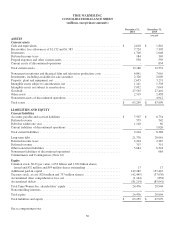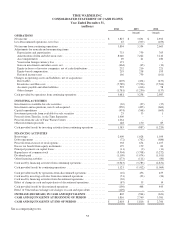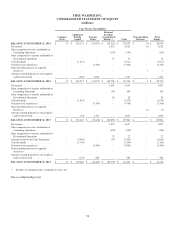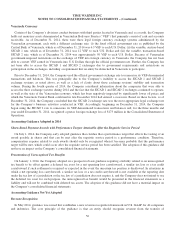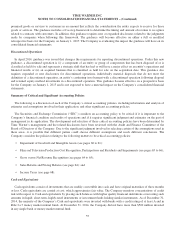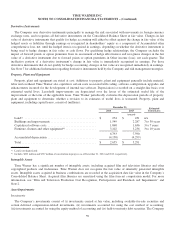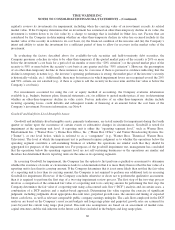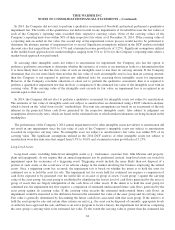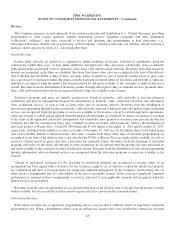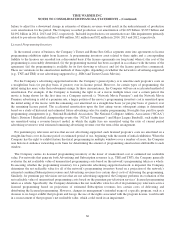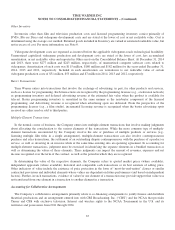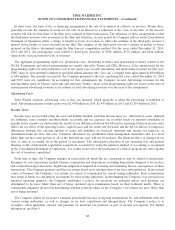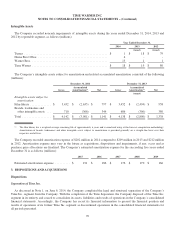Time Magazine 2014 Annual Report Download - page 76
Download and view the complete annual report
Please find page 76 of the 2014 Time Magazine annual report below. You can navigate through the pages in the report by either clicking on the pages listed below, or by using the keyword search tool below to find specific information within the annual report.TIME WARNER INC.
NOTES TO CONSOLIDATED FINANCIAL STATEMENTS – (Continued)
regularly reviews its investments for impairment, including when the carrying value of an investment exceeds its related
market value. If the Company determines that an investment has sustained an other-than-temporary decline in its value, the
investment is written down to its fair value by a charge to earnings that is included in Other loss, net. Factors that are
considered by the Company in determining whether an other-than-temporary decline in value has occurred include (i) the
market value of the security in relation to its cost basis, (ii) the financial condition of the investee and (iii) the Company’s
intent and ability to retain the investment for a sufficient period of time to allow for recovery in the market value of the
investment.
In evaluating the factors described above for available-for-sale securities and held-to-maturity debt securities, the
Company presumes a decline in value to be other-than-temporary if the quoted market price of the security is 20% or more
below the investment’s cost basis for a period of six months or more (the “20% criterion”) or the quoted market price of the
security is 50% or more below the security’s cost basis at any quarter end (the “50% criterion”). However, the presumption
of an other-than-temporary decline in these instances may be overcome if there is persuasive evidence indicating that the
decline is temporary in nature (e.g., the investee’s operating performance is strong, the market price of the investee’s security
is historically volatile, etc.). Additionally, there may be instances in which impairment losses are recognized even if the 20%
and 50% criteria are not satisfied (e.g., if there is a plan to sell the security in the near term and the fair value is below the
Company’s cost basis).
For investments accounted for using the cost or equity method of accounting, the Company evaluates information
available (e.g., budgets, business plans, financial statements, etc.) in addition to quoted market prices, if any, in determining
whether an other-than-temporary decline in value exists. Factors indicative of an other-than-temporary decline include
recurring operating losses, credit defaults and subsequent rounds of financing at an amount below the cost basis of the
Company’s investment. For more information, see Note 4.
Goodwill and Indefinite-Lived Intangible Assets
Goodwill and indefinite-lived intangible assets, primarily tradenames, are tested annually for impairment during the fourth
quarter or earlier upon the occurrence of certain events or substantive changes in circumstances. Goodwill is tested for
impairment at the reporting unit level. A reporting unit is either the “operating segment level,” such as Warner Bros.
Entertainment Inc. (“Warner Bros.”), Home Box Office, Inc. (“Home Box Office”) and Turner Broadcasting System, Inc.
(“Turner”), or one level below, which is referred to as a “component” (e.g., Warner Bros. Theatrical, Warner Bros.
Television). The level at which the impairment test is performed requires judgment as to whether the operations below the
operating segment constitute a self-sustaining business or whether the operations are similar such that they should be
aggregated for purposes of the impairment test. For purposes of the goodwill impairment test, management has concluded
that the operations below the operating segment level are not self-sustaining businesses or the operations are similar and
therefore has determined that its reporting units are the same as its operating segments.
In assessing Goodwill for impairment, the Company has the option to first perform a qualitative assessment to determine
whether the existence of events or circumstances leads to a determination that it is more likely than not that the fair value of a
reporting unit is less than its carrying amount. If the Company determines that it is not more likely than not that the fair value
of a reporting unit is less than its carrying amount, the Company is not required to perform any additional tests in assessing
Goodwill for impairment. However, if the Company concludes otherwise or elects not to perform the qualitative assessment,
then it is required to perform the first step of a two-step impairment review process. The first step of the two-step process
involves a comparison of the estimated fair value of a reporting unit to its carrying amount. In performing the first step, the
Company determines the fair value of a reporting unit using a discounted cash flow (“DCF”) analysis and, in certain cases, a
combination of a DCF analysis and a market-based approach. Determining fair value requires the exercise of significant
judgment, including judgments about appropriate discount rates, perpetual growth rates, the amount and timing of expected
future cash flows, as well as relevant comparable public company earnings multiples. The cash flows employed in the DCF
analyses are based on the Company’s most recent budgets and long range plans and perpetual growth rates are assumed for
years beyond the current long range plan period. Discount rate assumptions are based on an assessment of market rates,
capital structures and the risk inherent in the future cash flows included in the budgets and long range plans.
60


